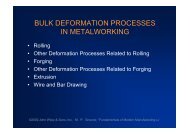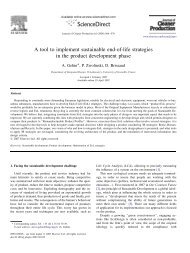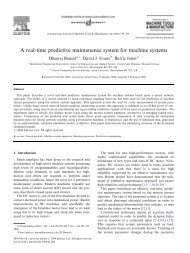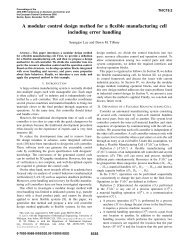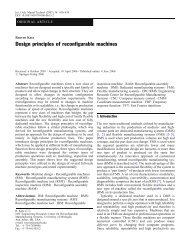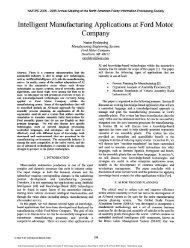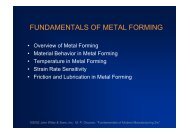Finite-Difference Equations and Solutions
Finite-Difference Equations and Solutions
Finite-Difference Equations and Solutions
You also want an ePaper? Increase the reach of your titles
YUMPU automatically turns print PDFs into web optimized ePapers that Google loves.
Multi-Dimensional Conduction:<br />
<strong>Finite</strong>-<strong>Difference</strong> <strong>Equations</strong><br />
<strong>and</strong><br />
<strong>Solutions</strong><br />
Chapter 4<br />
Sections 4.4 <strong>and</strong> 4.5
The <strong>Finite</strong>-<strong>Difference</strong> Method<br />
• An approximate method for determining temperatures at discrete<br />
(nodal) points of the physical system.<br />
• Procedure:<br />
– Represent the physical system by a nodal network.<br />
–Use the energy balance method to obtain a finite-difference<br />
equation for each node of unknown temperature.<br />
– Solve the resulting set of algebraic equations for the<br />
unknown nodal temperatures.
The Nodal Network <strong>and</strong> <strong>Finite</strong>-<strong>Difference</strong> Approximation<br />
• The nodal network identifies discrete points at which the temperature<br />
is to be determined <strong>and</strong> uses an (m,n) notation to designate their<br />
location.<br />
What is represented by the temperature determined at a nodal<br />
point, as for example, T m,n
• A finite-difference approximation is used to represent temperature<br />
gradients in the domain.<br />
How is the accuracy of the solution affected by construction of<br />
the nodal network<br />
What are the trade-offs between selection of a fine or a coarse mesh
Derivation of the <strong>Finite</strong>-<strong>Difference</strong> <strong>Equations</strong><br />
- The Energy Balance Method -<br />
• As a convenience that obviates the need to predetermine the direction<br />
of heat flow, assume all heat flows are into the nodal region of<br />
interest, <strong>and</strong> express all heat rates accordingly.<br />
Hence, the energy balance becomes:<br />
i i<br />
in+ Eg<br />
=<br />
E<br />
0<br />
(4.30)
• Consider application to an interior nodal point (one that exchanges heat by<br />
conduction with four, equidistant nodal points):<br />
4<br />
∑<br />
i=<br />
1<br />
() i →( m, n)<br />
i<br />
( )<br />
q + q ∆x⋅∆y⋅ =<br />
0<br />
where, for example,<br />
q k y<br />
( m−1, n) →( m,<br />
n) = ( ∆ ⋅)<br />
T<br />
−T<br />
m−1, n m,<br />
n<br />
∆x<br />
(4.31)<br />
Is it possible for all heat flows to be into the m,n nodal region<br />
• A summary of finite-difference equations for common nodal regions<br />
is provided in Table 4.2.
Consider an external corner with convection heat transfer.<br />
q q q<br />
1, ,<br />
+<br />
, 1 ,<br />
+<br />
,<br />
= 0<br />
( m− n) →( mn) ( mn− ) →( mn) ( ∞) →( mn)<br />
⎛∆y<br />
⎞T −T ⎛∆x<br />
⎞T −T<br />
k⎜ ⋅ ⎟ + k⎜ ⋅⎟<br />
⎝ 2 ⎠ ∆x<br />
⎝ 2 ⎠ ∆y<br />
m−1, n mn , mn , −1 mn ,<br />
⎛∆x<br />
⎞ ⎛∆y<br />
⎞<br />
+ h⎜ ⋅⎟( T∞<br />
− Tmn<br />
, ) + h⎜ ⋅⎟( T∞<br />
− Tmn<br />
, ) = 0<br />
⎝ 2 ⎠ ⎝ 2 ⎠<br />
or, with ∆ x=∆y,<br />
h∆x<br />
⎛h∆x<br />
⎞<br />
Tm−1, n+ Tmn , −1 + 2 T∞<br />
− 2⎜<br />
+ 1⎟Tmn<br />
, = 0<br />
k ⎝ k ⎠<br />
(4.43)
• Note potential utility of using thermal resistance concepts to express rate<br />
equations. E.g., conduction between adjoining dissimilar materials with<br />
an interfacial contact resistance.<br />
q<br />
( mn , −1 ) →( mn , )<br />
=<br />
T<br />
−T<br />
mn , −1 mn ,<br />
R<br />
tot<br />
R<br />
tot<br />
∆y/2 Rtc<br />
′′<br />
, ∆y/2<br />
= + +<br />
k x x k x<br />
A<br />
( ∆ ⋅) ∆ ⋅ ( ∆ ⋅)<br />
B<br />
(4.46)
<strong>Solutions</strong> Methods<br />
• Matrix Inversion: Expression of system of N finite-difference<br />
equations for N unknown nodal temperatures as:<br />
[ A] [ T] = [ C]<br />
(4.48)<br />
Coefficient<br />
Matrix (N x N)<br />
Solution Vector<br />
(T 1 ,T 2 , …T N )<br />
Right-h<strong>and</strong> Side Vector of Constants<br />
(C 1 ,C 2 …C N )<br />
−1<br />
Solution [ T] = [ A] [ C]<br />
(4.49)<br />
Inverse of Coefficient Matrix
• Gauss-Seidel Iteration: Each finite-difference equation is written in<br />
explicit form, such that its unknown nodal temperature appears<br />
alone on the left-h<strong>and</strong> side:<br />
C a<br />
a<br />
T T T<br />
( k) i−1<br />
( )<br />
N<br />
i<br />
ij k ij ( k −1)<br />
i = − j −<br />
j<br />
aii j= 1aii j= i+<br />
1aii<br />
∑ ∑ (4.51)<br />
where i =1, 2,…, N <strong>and</strong> k is the level of iteration.<br />
Iteration proceeds until satisfactory convergence is achieved<br />
for all nodes:<br />
i<br />
( k) ( k−1)<br />
T −T ≤ ε<br />
i<br />
• What measures may be taken to insure that the results of a<br />
finite-difference solution provide an accurate prediction of the<br />
temperature field
Example 4.3 A long column in a furnace (no heat generation)
Matrix Inversion
Gauss-Seidel Iteration
Homework 5<br />
• 4.4<br />
• 4.23<br />
• 4.51 (a)




